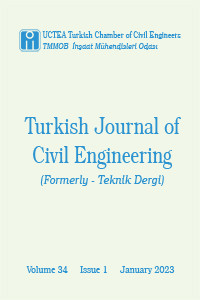Evaluation of Field Shear Wave Velocity in Deep Soil Mixing Based on Laboratory Studies
Deep soil mixing, Shear wave velocity, Conversion factor, Bender element, Resonant column
Evaluation of Field Shear Wave Velocity in Deep Soil Mixing Based on Laboratory Studies
Deep soil mixing, Shear wave velocity, Conversion factor, Bender element, Resonant column,
___
- AASHTO. “AASHTO LRFD bridge design specifications”, Washington, DC, 2012.
- ASCE. “Minimum Design Loads for Buildings and Other Structures”, ASCE/SEI 7-16. Reston, VA, 2016.
- CEN (European Committee for Standardization). “Design of Structures for Earthquake Resistance. Part 1—General rules, seismic actions and rules for buildings”, EN 1998-1 Eurocode 8. Brussels, Belgium, 2004.
- ICC (International Code Council). “International building code”, Country Club Hills, IL: ICC, 2018.
- Bate B, Cao J, Zhang C, Hao N, Wang S. Monitoring lime and cement improvement using spectral induced polarization and bender element techniques. Journal of Rock Mechanics and Geotechnical Engineering. 13(1):202-11, 2021.
- Piriyakul K, Iamchaturapatr J. Deep soil mixing method for the bio-cement by means of bender element test. In Advances in Laboratory Testing and Modelling of Soils and Shales 2017 Jan 18 (pp. 375-381). Springer, Cham.
- Canakci H, Güllü H, Dwle MI. Effect of glass powder added grout for deep mixing of marginal sand with clay. Arabian Journal for Science and Engineering. 43(4):1583-95, 2018.
- Madhyannapu RS, Puppala AJ, Nazarian S, Yuan D. Quality assessment and quality control of deep soil mixing construction for stabilizing expansive subsoils. Journal of geotechnical and geo-environmental engineering. 136(1):119-28, 2010.
- Gulen M., Kılıç H., “Determination of strength and deformation parameters of remolded clays by falling cone and veyn tests”, Teknik Dergi, 31(3): 9987-10012, 2020
- ASTM D 7400‐14. "Standard Test Methods for Downhole Seismic Testing", 2014.
- Kitazume, Masaki, and Masaaki Terashi, “The deep mixing method”, CRC Press, 2013.
- Viggiani, G. and Atkinson, J.H., “Interpretation of bender element tests”, Géotechnique: 45(1), 149–154, 1995.
- Federal Highway Administration (FHWA). “Design Manual: Deep Mixing for Embankment and Foundation Support”, United States Department of Transportation, Publication No. FHWA-HRT-13-046, 2013.
- ASTM D2845-08, “Standard Test Method for Laboratory Determination of Pulse Velocities and Ultrasonic Elastic Constants of Rock (Withdrawn 2017)”, DOI: 10.1520/D2845-08 ASTM International, West Conshohocken, PA, 2008.
- ASTM D2166, “Standard Specification for Unconfined Compressive Strength of Cohesive Soil”, West Conshohocken, PA, USA, 2006.
- ASTM D8295-19, “Standard Test Method for Determination of Shear Wave Velocity and Initial Shear Modulus in Soil Specimens Using Bender Elements”, ASTM International, West Conshohocken, PA, 2019.
- Kramer, S. L., “Geotechnical Earthquake Engineering”, Prentice Hall, Upper Saddle River, NJ, 1996.
- Chiara, N., Stokoe, K.H., “Sample Disturbance in Resonant Column Test Measurement of Small-Strain Shear Wave Velocity, Soil Stress-Strain Behavior: Measurement, Modeling and Analysis”, Geotechnical Symposium in Roma, March 16&17, 2006.
- Boone, Darrel, S., “A Comparison Between the Compressive Strength and the Dynamic Properties of Concrete as a Function of Time”, Master's Thesis, University of Tennessee, 2005.
- ISSN: 2822-6836
- Yayın Aralığı: 6
- Başlangıç: 1990
- Yayıncı: TMMOB İnşaat Mühendisleri Odası
Evaluation of Field Shear Wave Velocity in Deep Soil Mixing Based on Laboratory Studies
Entropy Based Regional Precipitation Prediction in the Case of Gediz River Basin
Özgür BOZOĞLU, Türkay BARAN, Filiz BARBAROS
Multi Agent System Based Risk Allocation Model for Public-Private-Partnership Type Projects (RAMP3)
Effect of Sub-Contractor Selection on Construction Project Success in Turkey
Ali Erkan KARAMAN, Koray SANDAL
The High Temperature Performance Evaluation of Polymer/Nanocomposite Modified Asphalt Cement
Mustafa ALAS, Ali ALBRKA, Hüseyin GÖKÇEKUŞ
Meteorological Drought Analysis for Helmand River Basin, Afghanistan
Gökmen TAYFUR, Mohammad Musa ALAMI
An Investigation on Force Modification Factors in Cold-Formed Steel Structures
Determination of Finite Element Modelling Errors for Box Culverts Using Field Load Tests
